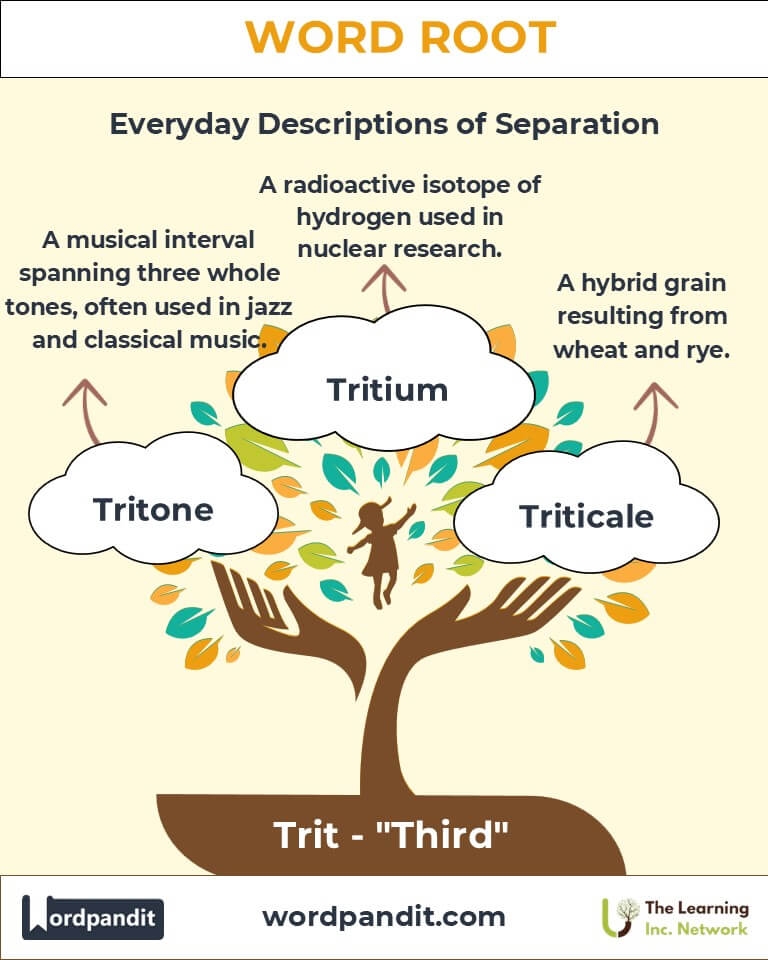Trit: The Root of Third in Language and Science
Explore the fascinating origins and significance of the root "trit," meaning "third." From scientific advancements like tritium, a radioactive isotope of hydrogen, to hybrid grains like triticale, this root connects ancient linguistic roots to modern innovations.

Table of Contents
- Introduction: The Essence of "Trit"
- Etymology and Historical Journey
- Mnemonic: Unlocking the Power of "Trit"
- Common "Trit"-Related Terms
- "Trit" Through Time
- "Trit" in Specialized Fields
- Illustrative Story: "Trit" in Action
- Cultural Significance of the "Trit" Root
- The "Trit" Family Tree
- FAQs about the "Trit" Word Root
- Test Your Knowledge: "Trit" Mastery Quiz
- FAQs about the "Trit" Word Root
- Test Your Knowledge: "Trit" Word Root Quiz
- Conclusion: The Living Legacy of "Trit"
Introduction: The Essence of "Trit"
The word root "trit" (pronounced as "trit") originates from the Latin term tertius, meaning "third." It underscores concepts of sequence, hierarchy, and science, appearing in diverse fields such as chemistry and agriculture. Its relevance ranges from the study of isotopes like tritium to agricultural innovations like triticale.

Etymology and Historical Journey
The Latin tertius transitioned into "trit," capturing the essence of "three" or "third." This root found its way into scientific terminology with the development of modern chemistry, where tritium, a "third" isotope of hydrogen, was named. Similarly, in agriculture, "trit" embodies innovation in hybrid grains like triticale, symbolizing progression.
Mnemonic: Unlocking the Power of "Trit"
Imagine a triangle—the quintessential representation of "three." The three sides of the triangle remind us of "trit," firmly anchoring the concept of "third" in our memory.
Mnemonic Device: "Trit is the triangle of thirds—scientific, symbolic, and systematic."
Common "Trit"-Related Terms
- Tritium (TRIH-tee-um): A radioactive isotope of hydrogen with one proton and two neutrons, commonly used in scientific research and nuclear energy.
Example: "The lab used tritium to study the behavior of radioactive isotopes." - Triticale (TRIH-tih-kayl): A hybrid grain combining wheat and rye to improve yield and resilience.
Example: "Farmers planted triticale for its adaptability to arid climates." - Tertiary (TUR-shee-ary): Relating to the third level or rank in a system.
Example: "Tertiary education prepares students for advanced careers." - Triadic (Try-AD-ik): Pertaining to a group of three, often used in art, music, and philosophy.
Example: "The triadic harmony in the song added depth to its melody."
"Trit" Through Time
The evolution of "trit" mirrors humanity's quest for categorization and understanding. From its classical origins in Latin to its incorporation into modern science, "trit" has consistently symbolized the "third" element of systems.
- Tritium (Modern Science): Coined in the 20th century, it highlights the application of "trit" in atomic research.
- Triticale (Agriculture): Developed in the 19th century, this term reflects the fusion of wheat and rye into a resilient grain.
"Trit" in Specialized Fields
- Chemistry:
Tritium serves as a crucial element in nuclear fusion and radioluminescence.
Example: Used in watch dials for illumination, it exemplifies "trit’s" scientific utility. - Agriculture:
Triticale showcases innovation in creating sustainable food sources.
Example: Its hybrid nature combines the benefits of two grains. - Mathematics:
Triadic Concepts are pivotal in geometric and numerical systems.
Example: The triangular number sequence reflects the symbolic nature of "three."
Illustrative Story: "Trit" in Action
In a remote research lab, Dr. Elena Carter studied tritium as part of a project to develop sustainable nuclear energy. Simultaneously, her brother, a farmer, experimented with triticale to combat soil degradation. Despite working in different fields, both siblings relied on the power of "trit"—symbolizing innovation and resilience in their respective endeavors.
Cultural Significance of the "Trit" Root
The concept of "three" holds cultural and symbolic importance across civilizations. From the Christian Holy Trinity to the triadic patterns in Eastern philosophy, the number "three" often represents harmony and completeness. "Trit" echoes this cultural reverence, embodying balance and progression.

The "Trit" Family Tree
- Tri- (Greek/Latin): Three.
- Triangle: A three-sided polygon.
- Tricycle: A three-wheeled vehicle.
- Tert- (Latin): Third.
- Tertiary: The third rank or level.
- Triad- (Greek): A group of three.
- Triad: A harmonious trio.
FAQs About " Trit "
Q: What does "Trit" mean?
A: The root "Trit" comes from the Latin word terere, meaning "to rub" or "to wear down." It is associated with processes of abrasion, erosion, or grinding, evident in words like attrition, contrite, and triturate.
Q: What is attrition?
A: Attrition refers to the gradual wearing down or reduction of something through friction or sustained pressure. This concept applies to various contexts, including physical abrasion, employee turnover, and military strategies.
Q: How does the term "contrite" connect to "Trit"?
A: "Contrite" describes a feeling of remorse or guilt that figuratively "grinds" a person’s heart. The connection lies in the metaphorical sense of being worn down by regret or sorrow.
Q: What does "triturate" mean in science?
A: Triturate means to grind or crush substances into a fine powder. This term is commonly used in pharmacology and material science when preparing compounds or samples for analysis or use.
Q: What is the significance of attrition in geology?
A: In geology, attrition occurs when rocks or particles rub against each other in rivers, glaciers, or deserts, leading to their gradual rounding and smoothing. This process contributes to the formation of sediment.
Q: How does "attrition" apply to human resources?
A: In HR, attrition refers to the natural reduction of a workforce through resignations, retirements, or other non-replacement causes. It differs from layoffs, as it is typically unplanned and passive.
Test Your Knowledge: " Trit " Mastery Quiz
1. What does the root "Trit" signify?
2. What is attrition?
3. What does "contrite" describe?
4. What is triturate commonly used for?
5. How does attrition affect rocks in nature?
Conclusion: The Living Legacy of "Trit"
The root "trit" beautifully bridges the ancient and modern, from symbolic representations of "three" to scientific breakthroughs. Its applications in fields like chemistry and agriculture underscore its versatility and relevance. As humanity continues to innovate, "trit" reminds us of the enduring importance of understanding and utilizing fundamental concepts like the "third."












